October 17, 2014
New York City: Power Stations in Flood Plain
By Todd Olinsky-Paul
According to a report from the New York City Resiliency Initiative, 88% of the city’s steam generating capacity, 53% of the in-city electric generation capacity, 37% of transmission substation capacity, and 12% of large distribution substation capacity currently lie within the 100-year floodplain.
However, the picture is actually much worse than that, because climate change is accelerating flooding events, making 100-year floods occur much more frequently. Today, a “100-year storm” means a surge flood of about two meters in New York City. A “500-year storm” indicates three-meter-high surge floods. Both scenarios would easily top Manhattan’s seawalls, which are only 1.5 meters high. But according to climate modeling by researchers at MIT and Princeton University, the greenhouse effect will soon cause two-meter surge floods every three to 20 years, and three-meter floods every 25 to 240 years in New York City. In other words, as sea levels rise, precipitation rates increase, and severe storms become more frequent, “100-year floods” can be expected to occur much more often, and cover a much larger area. As shown in the chart below, NYC planners project that by the 2020s, 87% of the in-city generation capacity will be in the floodplain, and by the 2050s, this will increase to 97%.
Since these large power stations cannot be easily relocated within the city, this would seem to be an argument for distributed generation and resilient power solutions.
Recognizing this problem, the New York State Energy Research and Development Authority (NYSERDA) has put in place a number of programs to promote and support resilient power and distributed generation. Aside from the $40 million New York Prize microgrids program, which will be rolled out soon, NYSERDA offers a number of funding opportunities for technologies ranging from solar to fuel cells to CHP, as well as building-integrated systems. To see a list of the current and upcoming funding opportunities in New York, click here.















